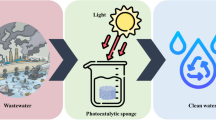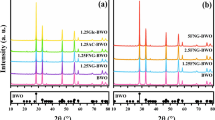Abstract
The light response range, reusability, and durability of photocatalyst are the key issues for its practical application. To address these problems, the C-doped TiO2/carbon nanofibrous (CTCNF) film with incorporation of C-doped TiO2 nanoparticles into carbon nanofibers was prepared by electrospinning and calcination (pre-oxidation and carbonization). All the obtained CTCNF films exhibited a promising light absorption in ultraviolet–visible region. With optimization of carbonization temperature, the CTCNF film carbonized at 800 °C (CTCNF-800) showed a strongest light absorption. Consequently, the CTCNF-800 possessed a highest photocatalytic degradation efficiency of 94.2% for degradation of rhodamine B. In addition, the CTCNF-800 possessed excellent flexibility and deserved mechanical strength, and hence, the CTCNF-800 could be easily segregated from solution and recycled. Satisfyingly, its degradation efficiency still exceeded 92% after using for six cycles, implying that the CTCNF had excellent reusability and well stability. Besides, the degradation efficiency was over 90% after the CTCNF-800 kept in air without illumination for 1 year, indicating its outstanding durability. The CTCNF film photocatalyst demonstrates tremendous potential in practical application for purification of wastewater.









Similar content being viewed by others
References
Miklos DB, Remy C, Jekel M, Linden G, Drewes JE, Hübner U (2018) Evaluation of advanced oxidation processes for water and wastewater treatment-A critical review. Water Res 139:118–131
Xing Z, Zhang J, Cui J, Yin J, Zhao T, Kuang J, Xiu Z, Wan N, Zhou W (2018) Recent advances in floating TiO2-based photocatalysts for environmental application. Appl Catal B Environ 225:452–467
Fujishima A, Zhang X, Tryk DA (2008) TiO2 photocatalysis and related surface phenomena. Surf Sci Rep 63:515–582
Wang Z, Luo C, Zhang Y, Gong Y, Wu J, Fu Q, Pan C (2018) Construction of hierarchical TiO2 nanorod array/graphene/ZnO nanocomposites for high performance photocatalysis. J Mater Sci 53:15376–15389. https://doi.org/10.1007/s10853-018-2724-3
Xu Y, Wen W, Wu JM (2018) Titania nanowires functionalized polyester fabrics with enhanced photocatalytic and antibacterial performances. J Hazard Mater 343:285–297
Liu X, Zhu G, Wang X, Yuan X, Lin T, Huang F (2016) Progress in black titania: a new material for advanced photocatalysis. Adv Energy Mater 6:1600452–1600480
Chae A, Jo S, Choi Y, Min B, Park SY, Insik I (2017) Visible-light-driven photocatalysis with dopamine-derivatized titanium dioxide/N-doped carbon core/shell nanoparticles. J Mater Sci 52:5582–5588. https://doi.org/10.1007/s10853-016-0629-6
Schneider J, Matsuoka M, Takeuchi M, Zhang J, Horiuchi Y, Anpo M, Bahnemann DW (2014) Understanding TiO2 photocatalysis: mechanisms and materials. Chem Rev 114:9919–9986
Lim J, Kwak D, Sieland F, Kim C, Bahnemann DW, Choi W (2018) Visible light-induced catalytic activation of peroxymonosulfate using heterogeneous surface complexes of amino acids on TiO2. Appl Catal B Environ 225:406–414
Liu J, Li Y, Ke J, Wang S, Wang L, Xiao H (2018) Black NiO–TiO2 nanorods for solar photocatalysis: recognition of electronic structure and reaction mechanism. Appl Catal B Environ 224:705–714
Wang S, Yun JH, Luo B, Butburee T, Peerakiatkhajohn P, Thaweesak S, Xiao M, Wang L (2017) Recent progress on visible light responsive heterojunctions for photocatalytic applications. J Mater Sci Technol 33:1–22
Zhang YF, Park SJ (2017) Au–pd bimetallic alloy nanoparticle-decorated BiPO4 nanorods for enhanced photocatalytic oxidation of trichloroethylene. J Catal 355:1–10
Zhang YF, Park SJ (2018) Bimetallic AuPd alloy nanoparticles deposited on MoO3 nanowires for enhanced visible-light driven trichloroethylene degradation. J Catal 361:238–247
Cheng H, Hu M, Zhai Q, Li S, Jiang Y (2018) Polydopamine tethered CPO/HRP-TiO2 nano-composites with high bio-catalytic activity, stability and reusability: enzyme-photo bifunctional synergistic catalysis in water treatment. Chem Eng J 347:703–710
Guesh K, Márquez-Álvarez C, Chebude Y, Díaz I (2016) Enhanced photocatalytic activity of supported TiO2 by selective surface modification of zeolite Y. Appl Surf Sci 378:473–478
Binaeian E, Tayebi HA, Rad AS, Payab M (2017) Surface modification of mesoporous silicate by tannin for immobilization of TiO2 nanoparticles: study of photocatalytic performance. Mater Chem Phys 185:14–23
Guo W, Zhang F, Lin C, Wang Z (2012) Direct growth of TiO2 nanosheet arrays on carbon fibers for highly efficient photocatalytic degradation of methyl orange. Adv Mater 24:4761–4764
Chaúque EFC, Adelodun AA, Dlamini LN, Greyling CJ, Ray SC, Ngila JC (2017) Synthesis and photocatalytic application of TiO2 nanoparticles immobilized on polyacrylonitrile nanofibers using EDTA chelating agents. Mater Chem Phys 192:108–124
Lin L, Wang H, Xu P (2017) Immobilized TiO2-reduced graphene oxide nanocomposites on optical fibers as high performance photocatalysts for degradation of pharmaceuticals. Chem Eng J 310:389–398
Du P, Song L, Xiong J, Wang L, Li N (2013) A photovoltaic smart textile and a photocatalytic functional textile based on co-electrospun TiO2/MgO core–sheath nanorods: novel textiles of integrating energy and environmental science with textile research. Text Res J 83:1690–1702
Shi Y, Yang D, Li Y, Qu J, Yu ZZ (2017) Fabrication of PAN@TiO2/Ag nanofibrous membrane with high visible light response and satisfactory recyclability for dye photocatalytic degradation. Appl Surf Sci 426:622–629
Xu P, Shen X, Luo L, Shi Z, Liu Z, Chen Z, Zhu M, Zhang L (2018) Preparation of TiO2/Bi2WO6 nanostructured heterojunctions on carbon fibers as a weaveable visible-light photocatalyst/photoelectrode. Environ Sci Nano 5:327–337
Kim S, Lim SK (2008) Preparation of TiO2-embedded carbon nanofibers and their photocatalytic activity in the oxidation of gaseous acetaldehyde. Appl Catal B Environ 84:16–20
Xu Z, Li X, Wang W, Shi J, Teng K, Qian X, Shan M, Li C, Yang C, Liu L (2016) Microstructure and photocatalytic activity of electrospun carbon nanofibers decorated by TiO2 nanoparticles from hydrothermal reaction/blended spinning. Ceram Int 42:15012–15022
Teng D, Yu Y, Liu H, Yang X, Ryu S, Lin Y (2009) Facile fabrication of heterostructured TiO2−xNx/CNFs as an efficient visible-light responsive photocatalyst. Catal Commun 10:442–446
Wu N, Wang Y, Lei Y, Wang B, Han C (2014) Flexible N-doped TiO2/C ultrfine fiber mat and its photocatalytic activity under simulated sunlight. Appl Surf Sci 319:136–142
Song L, Guan Y, Du P, Yang Y, Ko F, Xiong J (2016) Enhanced efficiency in flexible dye-sensitized solar cells by a novel bilayer phototanode made of carbon nanotubes incorporated TiO2 nanorods and branched TiO2 nanotubes. Sol Energy Mater Sol Cells 147:134–143
Song L, Yin X, Xie X, Du P, Xiong J, Ko F (2017) Highly flexible TiO2/C nanfibrous film for flexible dye-sensitized solar cells as a platinum-and transparent conducting oxide-free flexible counter electrode. Electrochim Acta 255:256–265
Tian J, Leng Y, Cui H, Liu H (2015) Hydrogenated TiO2 nanobelts as highly efficient photocatalytic organic dye degradation and hydrogen evolution photocatalyst. J Hazard Mater 299:165–173
Wang Z, Yoshinaga K, Bu XR, Zhang M (2015) Low temperature fabrication and photocatalytical activity of carbon fiber-supported TiO2 with different phase compositions. J Hazard Mater 290:134–141
Warkhade SK, Gaikwad GS, Zodape SP, Pratap U, Maldhure AV, Wankhade AV (2017) Low temperature synthesis of pure anatase carbon doped titanium dioxide: an efficient visible light active photocatalyst. Mater Sci Semicond Process 63:18–24
Liu J, Zhang Q, Yang J, Ma H, Tade MO, Wang S, Liu J (2014) Facile synthesis of carbon-doped mesoporous anatase TiO2 for the enhanced visible-light driven photocatalysis. Chem Commun 50:13971–13974
Zhang P, Shao C, Zhang Z, Zhang M, Mu J, Guo Z, Sun Y, Liu Y (2011) Core/shell nanofibers of TiO2@carbon embedded by Ag nanoparticles with enhanced visible photocatalytic activity. J Mater Chem 21:17746–17753
Wu YM, Xing MY, Zhang JL (2011) Gel-hydrothermal synthesis of carbon and boron co-doped TiO2 and evaluating its photocatalytic activity. J Hazard Mater 192:368–373
Zhang P, Shao C, Zhang Z, Zhang M, Mu J, Guo Z, Liu Y (2011) TiO2@carbon core/shell nanofibers: controllable preparation and enhanced visible photocatalytic properties. Nanoscale 3:2943–2949
Yi Q, Zhou Y, Xing M, Zhang J (2016) Vacuum activation-induced Ti3+ and carbon co-doped TiO2 with enhanced solar light photo-catalytic activity. Res Chem Intermed 42:4181–4189
Khavar AHC, Moussavi G, Mahjoub AR, Satari M, Abdolmaleki P (2018) Synthesis and visible-light photocatalytic activity of In, S-TiO2@rGO nanocomposite for degradation and detoxification of pesticide atrazine in water. Chem Eng J 345:300–311
Acknowledgements
This study was supported by the Program for Zhejiang Provincial Natural Science Foundation of China (LZ16E020002); Science Foundation (17012144-Y); and Program of Key Laboratory of Advanced Textile Materials and Manufacturing Technology, Ministry of Education (2017QN04) of Zhejiang Sci-Tech University.
Author information
Authors and Affiliations
Corresponding authors
Electronic supplementary material
Below is the link to the electronic supplementary material.
Rights and permissions
About this article
Cite this article
Song, L., Jing, W., Chen, J. et al. High reusability and durability of carbon-doped TiO2/carbon nanofibrous film as visible-light-driven photocatalyst. J Mater Sci 54, 3795–3804 (2019). https://doi.org/10.1007/s10853-018-3105-7
Received:
Accepted:
Published:
Issue Date:
DOI: https://doi.org/10.1007/s10853-018-3105-7




